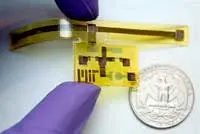 To demonstrate flexible, printable electronics that combine sensors and processing circuitry, MIT researchers have designed and built a device that responds to mechanical stresses by changing the colour of a spot on its surface.
To demonstrate flexible, printable electronics that combine sensors and processing circuitry, MIT researchers have designed and built a device that responds to mechanical stresses by changing the colour of a spot on its surface.
According to the research team, covering a robot or plane with sensors will require a technology that is both flexible and cost-effective to manufacture in bulk. The team think that 3D printing could be the answer.
"In nature, networks of sensors and interconnects are called sensorimotor pathways," says graduate student Subramanian Sundaram. "We were trying to see whether we could replicate sensorimotor pathways inside a 3D-printed object. So we considered the simplest organism we could find."
Printed substrates open the possibility of devices that, although printed as flat sheets, can fold themselves up into more complex, 3D shapes.
The researchers' device is T-shaped. The crossbar is made from an elastic plastic, with a strip of silver running its length. The base of the T is made from a rigid plastic and includes two printed transistors and a ‘pixel’, a circle of semiconducting polymer whose colour changes when the crossbars stretch, modifying the electrical resistance of the silver strip.
According to Sundaram, demonstrating working transistors was essential because large, dense sensor arrays require some capacity for on board signal processing.
To build the device, the researchers used ultraviolet radiation to ‘cure’ the fluids deposited by the print heads which produced the device's substrate.
In a standard transistor, there's an insulator between the gate and the semiconductor, to prevent the gate current from leaking into the semiconductor channel.
The transistors in the MIT researchers' device separate the gate and the semiconductor with a layer of water containing a potassium salt. Charging the gate drives potassium ions into the semiconductor, changing its conductivity.
The layer of saltwater lowers the device's operational voltage, so that it can be powered with an ordinary 1.5V battery.
"I think we can probably get it to work stably for two months, maybe," Sundaram says. "One option is to replace the liquid with something between a solid and a liquid, like a hydrogel, perhaps."
Author
Peggy Lee
Source: www.newelectronics.co.uk
